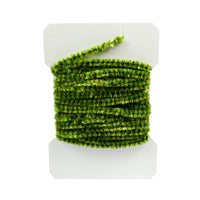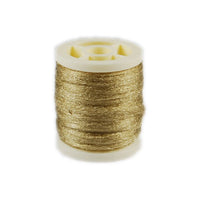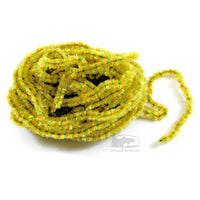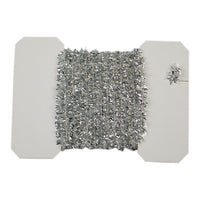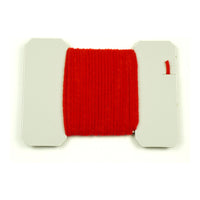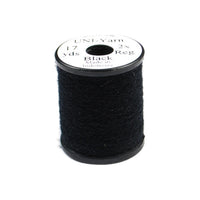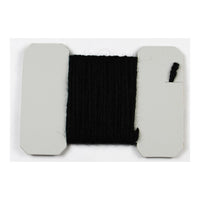
Fly Tying Chenille & Yarn
Fly tying chenille, yarns, and similar products. Including popular options like Cactus Chenille, Estaz, Polar Chenille, Mohair Leech Yarn, Palmer Chenille, Sparkle Yarn, Antron Yarn, Pearl Core Braid, Mcflylon, Flat Diamond Braid, and variegated chenille. Even yarn specifically for chironomid gills! The right product can make all the difference in your flies. Give us a call or email if we can help you find the right fly tying materials for your next fly masterpiece.
Read more
When it comes to building effective and visually striking flies, fly tying chenille & yarn are indispensable materials. These versatile fibers are used across fly types—from Woolly Buggers to egg patterns to classic Spey flies. Over the years, the variety of fly tying chenille & yarn available has expanded dramatically, giving tiers more creative freedom than ever.
Whether you're after natural textures or synthetic flash, there’s a chenille or yarn product out there to meet your fly tying needs. Below is a detailed overview of some of the most popular and useful types of fly tying chenille & yarn on the market today.
Standard Chenille
Standard chenille has been used in fly tying since the 1800s. It's a go-to material for bodies on Woolly Buggers, stonefly nymphs, and classic steelhead flies. Choosing the right size of standard chenille depends on your hook size and desired body thickness. Fine, medium, and large sizes offer flexibility for flies ranging from size 12 to size 4 or larger. A staple in the world of fly tying chenille & yarn, this material is reliable, simple to use, and widely available.
Ultra Chenille (Vernille)
Ultra Chenille, also known as Vernille, is a dense, smaller-diameter chenille that’s most famously used for the San Juan Worm. It also appears in micro nymphs, dry flies, and saltwater patterns like the Squimp. Available in Standard and Micro sizes, it’s a popular choice for woven bodies and compact profiles. Among fly tying chenille & yarn options, Ultra Chenille stands out for its clean look and easy handling.
Fluorescent Nylon Chenille
Designed for vivid color and high visibility, Fluorescent Nylon Chenille is a synthetic version of standard chenille. It’s widely used in Egg Sucking Leeches and other attractor patterns. When brightness matters—like in steelhead, salmon, and even saltwater flies—this chenille earns its place. As a member of the fly tying chenille & yarn family, it's a must-have for eye-catching, high-contrast designs.
Variegated & Speckled Chenille
Variegated Chenille is standard chenille with a twist—alternating colors that give a barred or grizzly appearance. This look is popular in Pat’s Rubber Legs and Woolly Buggers. Speckled chenille takes it a step further by adding subtle flashes of opalescent fibers, giving flies more depth. Both options are great for stoneflies and other patterns needing color variation.
Flashy Chenille: Cactus, Estaz, ICE & Tinsel
Fly tiers who want more flash turn to Cactus Chenille, Estaz, ICE Chenille, and Tinsel Chenille. These options feature larger fibers made from reflective synthetic materials. They’re excellent for flashy streamer bodies, egg imitations, and saltwater or bass flies. With Micro, Standard, and Grande sizes available, these flashy materials cover a wide range of applications. These styles dominate the modern synthetic side of fly tying chenille & yarn.
Polar Chenille
Similar to Cactus Chenille but with long, soft, and sparse fibers, Polar Chenille adds movement and light reflection. It's often used in patterns like the Chrome Magnet for steelhead. Palmer it for a hackle-like effect, or wrap it tightly for a body with subtle animation. Within the world of fly tying chenille & yarn, Polar Chenille excels in steelhead, salmon, and large trout streamers.
Yarns
Yarns have long been used to craft fly bodies, tails, and wings. Each yarn brings a specific texture and use case to the table.
Wool yarn is classic and has been used for centuries, while synthetic sparkle and Antron yarns add sheen and shine to many trout and caddis patterns. Polypro floating yarn is puffy and ideal for dry fly wings, wing posts on parachute dry flies, strike indicators, and even practicing fly casting. Uni-Yarn is a thin diameter yarn perfect for classic Spey flies and is convenient on a spool for bobbin use.
Chironomid gill yarn is soft and fluffy, perfect for imitating the gills on chironomid pupae, which is productive for lake fishing in the Northwest and British Columbia. McFlyfoam is a dense, spongy yarn perfect for tying egg patterns like Glo Bugs or Egg Sucking Leeches. Mohair leech yarn is excellent for tying fast, simple leech patterns by wrapping the yarn body on a streamer hook, and combining two colors can create a mottled, lifelike appearance. With all these options in chenille and yarn, fly tiers have the tools to create durable, effective, and beautiful flies for every situation.

